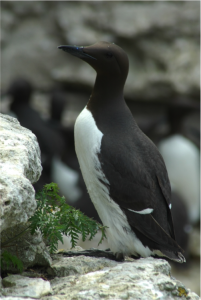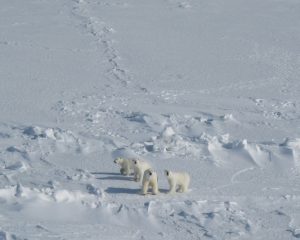To obtain code for completed projects, please look for us on GitHub.
Current Projects
- Survey design for invasive brown treesnakes on Guam
- Integrated population modeling for streaked horned larks
- Seabird populations at Channel Islands National Park
- Seabird population response to threats at Tetiaroa, French Polynesia
- Synchrony in seabird survival
- A population model for listed salmonids in the Columbia River Basin
- Demography of pigeon guillemots in Puget Sound, Washington
- Integrated population modeling for Cook Inlet beluga whales
- Integrated population modeling for Steller sea lions in the Aleutian Islands
- Population dynamics of grey wolves in Washington State
Survey design for invasive brown treesnakes on Guam
Funding: Department of Defense; Commander, Joint Region Marianas
Collaborators: Department of Defense, U.S. Geological Survey, U.S. Department of Agriculture
Contact: Staci Amburgey
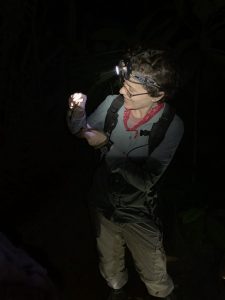
The brown treesnake (Boiga irregularis) is a type of snake native to Australia, Indonesia, Papua New Guinea, and several other nearby islands in the Pacific Ocean. In the 1940s, the snake was accidentally brought to Guam and the invasive species quickly spread across the island, decimating Guam’s birds, lizards, and mammals. Eleven bird species no longer live on the island, and some of these bird species that were found only on Guam are now officially extinct. However, captive bred populations or wild populations on nearby islands still exist for some species and can potentially be used for reintroduction efforts. Since the snakes are difficult to find and remove, one of the biggest steps in determining if and when reintroduction is feasible is evaluating the current brown treesnake situation on Guam. We are assessing if cost-effective camera trapping can be used to estimate the number of snakes in study areas. Since individual snake identity is unknown, we use different types of unmarked models to see if abundance estimates match numbers of snakes in a closed population of known size. By using photographs from camera traps, baited traps, and field surveys by researchers, we can investigate the cost-effectiveness of different study designs and management actions. This information will allow managers to predict how the number of snakes might change as we try to remove them and reintroduce the birds that belong on Guam.
Integrated population modeling for streaked horned larks
Funding: University of Washington College of the Environment
Collaborators: Ecostudies Institute, Washington Department of Fish and Wildlife
Contact: Abby Bratt

The streaked horned lark (Eremophila alpestris strigata) is a subspecies of horned lark native to the Pacific Northwest. Its historic range includes the prairie-oak and coastal plains habitats of British Columbia, Washington, and Oregon. Among other threats, habitat loss and fragmentation have led to significant decline in the population. The species was listed as Threatened under the Endangered Species Act in 2013 and is endangered in Washington state. The largest breeding population in the South Puget Sound is on Joint Base Lewis McChord, where extensive nest monitoring, mark-resight, territory mapping, and count surveys are conducted during the breeding season. We are using these data to develop a spatially-explicit integrated population model to better estimate demographic parameters such as abundance, survival, and movement. As an early-successional species, managing habitat for streaked horned larks generally requires prescribed burns. Thus, results from the integrated population model will be used to assess the effectiveness of past management actions as well as plan future disturbance on the prairies. We are also using this data set to explore modeling solutions for instances where individuals can only be partially identified, either because they are not uniquely marked or because they can only be partially observed, which will be applicable to countless other populations and mark-recapture studies.
Seabird populations at Channel Islands National Park
Funding: Channel Islands National Park
Collaborators: California Institute of Environmental Studies, Montrose Settlements Restoration Program, U.S. Geological Survey Western Ecological Research Center – Santa Cruz Field Station
Contact: Amelia J. DuVall
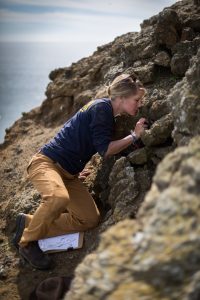
Channel Islands National Park provides essential habitat for marine avifauna, including vital nesting and feeding grounds for 99% of the seabirds in southern California and important breeding areas, wintering areas, and migratory stopovers for shorebirds. At least fourteen seabirds and shorebirds use the islands for essential breeding grounds and an additional three are suspected to have bred there historically. There is no current information on the baseline status and trends in demographic parameters and population abundance for several key avifauna at the park. These taxa are being impacted by existing stressors (e.g., disturbance via light pollution and increased park visitation, depredation, loss of nesting habitat) and could be significantly affected by future stressors (e.g., offshore wind energy development, changes in prey distribution and habitat due to climate change). This project fills a critical knowledge gap on the population trends for eight priority taxa identified by Channel Islands National Park for the seabird monitoring program. We are analyzing long-term monitoring data to provide estimates of relative abundance and reproductive success over time as a function of environmental conditions such as sea surface temperature and forage fish abundance. This information will be used to conduct in-depth program reviews to refine the seabird monitoring program and prioritize management and conservation actions.
Seabird population response to threats at Tetiaora, French Polynesia
Funding: Private Funders
Collaborators: Dr. Beth Gardner and Dr. Julia Parrish (University of Washington), Tetiaroa Society
Contact: Amelia J. DuVall
Seabirds are one of the most endangered groups of birds worldwide. The introduction of mammalian predators to breeding islands, by-catch in fishing vessels, and changing ocean conditions related to climate change all represent threats to seabirds. Tetiaroa, a private atoll in French Polynesia with a land area of only about 6 square kilometers, is home to tens of thousands of breeding seabirds of 10 different species. In this incredible natural laboratory, we are studying pre-rat eradication seabird communities ahead of a planned eradication of rats in 2020. Coupling these pre-eradication studies with post-eradication studies will allow us to better understand the effects of introduced predators and the benefits that may be derived from eradication. We are also initiating a long-term banding program at Tetiaroa in order to track individuals across their lifetimes to better understand the relationships between survival and ocean conditions. Our focal species at Tetiaroa include the red-footed booby (Sula sula), the brown booby (Sula leucogaster), the brown noddy (Anous stolidus), the sooty tern (Onychoprion fuscatus), and the greater crested tern (Thalasseus bergii). In 2020, we also plan to attach GPS tags to the largest of these species – the red-footed booby and the brown booby – to determine where these species forage both during and outside the breeding season.
Synchrony in seabird survival
Funding: Swedish Research Council
Collaborators: Swedish Museum of Natural History, Aarhus University, Norwegian Institute for Nature Research, Centre for Ecology & Hydrology
Contact: Sarah Converse
Seabirds are excellent model systems to study spatiotemporal patterns of anthropogenic impact in marine systems. For example, consider the effects of storms occurring with higher frequency due to climate change. While the direct effects may be local or regional, the ecological impact may manifest on different scales if birds from multiple breeding colonies concentrate in one area when they are simultaneously affected by the weather event. A shared driver affecting several populations can be detected via synchronous variation in population numbers or demographic parameters. Such synchrony renders the metapopulation more vulnerable to extinction, as single events or sudden changes to environmental conditions may have catastrophic impacts across the species’ entire range. Synchrony also illustrates ecological connectedness, the scale at which threats influence populations or species. We are using hierarchical models to investigate synchrony in seabird survival and its impact on population trends in these long-lived species. We use two species which breed over large areas of the North Atlantic as our case studies: the common murre (Uria aalge) and the European shag (Phalacrocorax aristotelis). During the winter, the shag migrates a short distance while the murre disperses much more widely. This contrast allows us to get behavior-specific insights about seabird population response to environmental change, with an emphasis on interactions across scales.
A population model for listed salmonids in the Columbia River Basin
Funding: National Oceanic and Atmospheric Administration, Northwest Fisheries Science Center
Collaborators: National Oceanic and Atmospheric Administration, Northwest Fisheries Science Center, Washington Department of Fish and Wildlife, Yakama Nation Fisheries, Biomark Applied Biological Services
Contact: Mark Sorel
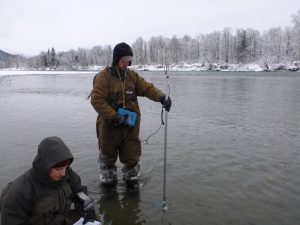
Within the Interior Columbia River Basin, there are three Evolutionarily Significant Units of Chinook salmon (Oncorhynchus tshawytscha) and three Distinct Population Segments of steelhead trout (Oncorhynchus mykiss) listed under the Endangered Species Act. These populations remain at low abundance due to degradation of spawning and juvenile rearing habitats and dams in their migration corridor, among other factors. Tools for recovery include restoration of spawning and rearing habitat, conservation hatcheries, predator control, and dam management to facilitate migration. However, these actions are expensive and allocating resources with maximal efficiency is necessary for salmon recovery. Therefore, information is required to understand how both management actions, coupled with the increasing threat of climate change, will influence population viability. We are developing an integrated population model that will be fit to spatio-temporal data sets including, 1) spawner abundance and juvenile productivity in freshwater, and 2) mark-recapture data on the survival of salmon throughout their life cycle. By fully utilizing the available datasets through integrated modeling we can describe the uncertainties present in each data set while allowing information to be shared among them. The model will be used to predict the effects of management actions affecting specific life stages, such as reproduction, on population viability. This work will inform recovery plans and optimize the allocation of resources to improve population outcomes.
Demography of pigeon guillemots in Puget Sound, Washington
Funding: National Science Foundation
Collaborators: Guillemot Research Group
Contact: Amanda Warlick

Pigeon guillemots (Cepphus columba) are one of only three alcids that nest in Puget Sound. Despite having been identified as an indicator species for the region, little research has been done on the demographics of Pacific coast populations. This project is a collaboration with the Guillemot Research Group, a citizen science data collection program that has been monitoring these birds during the breeding season since 2008 on Whidbey Island, WA. Pigeon guillemots nest in unobservable nests on cliff sides and chicks fledge at night, so the nest outcomes are uncertain. Thus, we use counts of adult birds delivering prey to nests as the foundation of an integrated population model built on a novel multi-event parameterization to estimate reproductive success. This project accounts for life history traits and features of the data collection protocol that complicate both the ecological and observation processes in order to examine trends in local abundance and reproduction. As an indicator species, pigeon guillemots are an important component of nearshore ecosystems throughout Puget Sound, likely affected by environmental variability (e.g., pollution, coastal development, and changes in the distribution and availability of local forage fish). This work highlights the importance of citizen science initiatives and will inform ongoing conservation, monitoring, and management efforts for this species, other seabirds, forage fish, and ecosystem resilience throughout the Puget Sound region.
Integrated population modeling for Cook Inlet beluga whales
Funding: National Marine Fisheries Service Marine Mammal Laboratory
Collaborators: National Marine Fisheries Service Marine Mammal Laboratory & NMFS Alaska Regional Office
Contact: Amanda Warlick

The Cook Inlet population of beluga whales (Delphinapterus leucas) in Alaska is the smallest of all beluga populations throughout the Arctic and is considered Endangered. Though substantial uncertainty exists about both recent and historical abundance estimates, the population is estimated to have declined by approximately 75% since 1979 and the observed recovery rate since hunting has stopped has been much lower than what would be expected for a long-lived species at low population size. This project aims to develop an integrated population model from aerial survey and mark-recapture data to estimate trends in adult survival and population abundance while accounting for the challenges of detecting variable group sizes in turbid waters and having limited to no information on reproduction and juvenile survival. The results of this integrated model will ultimately inform population viability analyses and competing hypotheses about factors that may be limiting their recovery to determine what, if any, management actions could offset the effects of the most impactful anthropogenic activities.
Integrated population modeling for Steller sea lions in the Aleutian Islands
Funding: National Science Foundation
Collaborators: National Marine Fisheries Service Marine Mammal Laboratory
Contact: Amanda Warlick
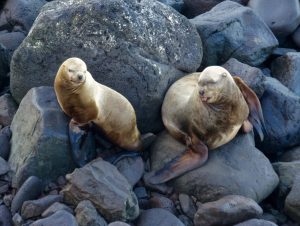
Over the last three decades, researchers have proposed numerous competing hypotheses as to the driving forces behind the precipitous decline of Steller sea lions (Eumetopias jubatus) during the 1970s and the subsequent divergent recovery rates observed across the species’ range. We use an integrated population model to enhance our knowledge about the age-specific linkages between demographic rates and oceanographic conditions in the context of a changing climate. Integrated population models have emerged as an important tool for improving the estimation of vital rates and other demographic parameters for wildlife populations particularly when there may not be data to inform the estimation of a particular parameter using more traditional approaches. Here, the combination of aerial survey and mark-recapture data facilitates a more precise accounting for and treatment of neonate mortality, unknown female reproductive state observations, and age-specific abundance across the Aleutian Islands. The integrated population model will be the foundation of a population viability analysis aimed at understanding which demographic rates are driving population dynamics and potentially limiting recovery for the population.
Population dynamics of grey wolves in Washington State
Funding: Washington Department of Fish and Wildlife
Collaborators: Washington Department of Fish and Wildlife, Washington State University, National Park Service, Woodland Park Zoo
Contact: Lisanne Petracca

The grey wolf (Canis lupus) is currently recolonizing Washington State, with the first breeding pack observed in 2008. Wolves are state endangered, and there is interest in understanding both present and future wolf population dynamics and evaluating progress towards statewide recovery goals. We are assessing how to combine data from GPS collars on wolf individuals and winter aerial surveys of wolf packs in a single model framework, so that we can estimate [1] wolf abundance, survival, movement rates, and reproductive rates in the years over which data were collected [2009-2020], [2] potential colonization patterns of grey wolves in the future [2021-2070], and [3] how various scenarios will affect future wolf populations. These scenarios include translocation, disease, harvest, a cessation of immigration from out of state, and increasing wolf removals by the state agency. Our model will provide insight on probability of recovery, probability of extinction (i.e., zero individuals at year 50), and population growth rate over the next 50 years and will be used to guide grey wolf management in Washington.
Past Projects
Understanding common loon distribution in Washington
Funding: Washington Department of Fish and Wildlife, University of Washington
Collaborators: Washington Department of Fish and Wildlife
Contact: Hannah Sipe
In Washington, common loons (Gavia immer) are a state-listed Sensitive species and a species in need of conservation, per Washington State’s Wildlife Action Plan. Despite this, little is known about the breeding and non-breeding distribution of this species within the state. Breeding common loons establish territories on secluded lakes with low human disturbance in the summer months, while non-breeding common loons can be found in rivers and lakes throughout Washington. Due to the secluded nature of their breeding territories, it is difficult for biologists to survey all areas where common loons are suspected to be breeding. In an effort to gain more information about this sensitive species, we are integrating citizen science eBird data with the Washington Department of Fish and Wildlife’s breeding data on common loons in a multi-state occupancy model. Using two data types within an occupancy model framework allows for a better understanding of the distribution of breeding and non-breeding common loons across Washington. In addition, the results from the occupancy model are useful in designing an optimal approach for future monitoring of this species and the ability to detect trends over time. The occupancy model results and the optimal survey design will provide management with the information and tools necessary to decision-making around common loons in Washington.
Unifying abundance and movement ecology: Understanding how polar bears move, exploit habitat, and survive in the Arctic
Funding: North Pacific Research Board
Collaborators: U.S. Geological Survey, U.S. Fish and Wildlife Service, University of Washington Polar Science Center
Contact: Nathan Hostetter
Polar bear (Ursus maritimus) populations in Alaska and Canada are of high management and conservation concern, particularly in the face of climate change. Ecologists commonly use capture-recapture and telemetry data to evaluate the spatial ecology of animal populations like polar bears. Although capture-recapture and telemetry both inherently contain information on population dynamics, the resulting data are often analyzed separately to investigate abundance and movement, respectively. We are developing frameworks to unify concepts of abundance and movement modeling to simultaneously estimate density, habitat use, and movement of animal populations. By exploiting a variety of data sources, we will be able to develop a better understanding of how polar bears move, exploit habitat, reproduce, and survive. More broadly, integrated abundance-movement models provide a framework linking spatial, landscape, and movement ecology across a variety of study designs, taxa, and ecosystems.

